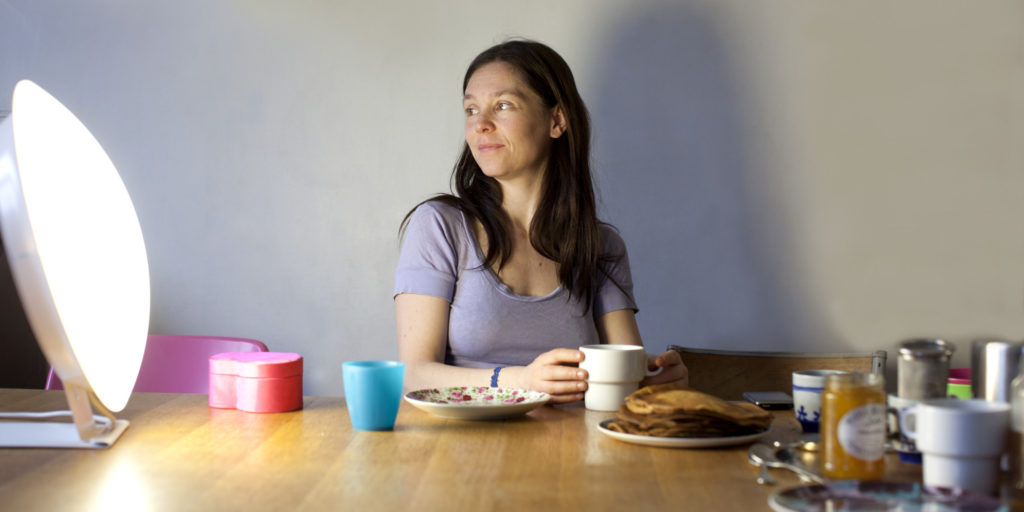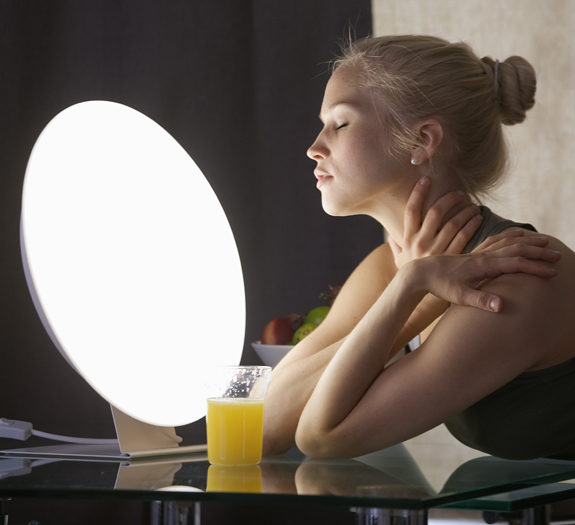Light Therapy: Do you know a natural way to reduce the “blues” and the loss of energy associated with the winter? In fact, there is light therapy. This type of lighting has been found to reduce seasonal depression and increase your vitality. Learn how by becoming familiar with the benefits of light therapy. Light therapy involves exposing yourself daily to a white artificial light, known as “broad spectrum”, imitating the sun. Its purpose is mainly to treat disorders associated with disturbances of the internal biological clock, as seasonal depression.
Light therapy is part of the great family of phototherapy using certain light sources (various colors and intensities, laser, etc.), sometimes combined with photosensitizers, to cure all sorts of ailments, particularly skin diseases.
Light Therapy: Against seasonal depression, and more
The main application of light therapy, and also one that is best documented scientifically, concerns SAD. This syndrome occurs with the approach of winter, with decreasing external light, and has a detrimental effect on the internal biological clock of some people. The origin of this syndrome is unknown. Light therapy is a recognized medical treatment to combat SAD. In the Nordic countries, from 3% to 6% of individuals, and even up to 10%, according to some sources, 1-4 suffer from SAD. They then have symptoms such as depressed mood, chronic fatigue, decreased libido, an exaggerated need for sleep, difficulty awakenings, binge eating, or abnormally large appetite, especially for sugar and carbohydrates (bread, pasta, potatoes).
In Canada nearly 3% of the population would be affected by the seasonal depression, while 18% would live a “winter blues” characterized by disturbing symptoms but less disabling than SAD. It also uses light therapy to counter other symptoms that are associated with a disruption of the biological clock, such as sleep disorders and premenstrual syndrome or to combat the problems with jet lag or night work. It could also be useful in some cases of depression as postpartum (after childbirth) or non-seasonal depression in the elderly. Light therapy may also have preventive properties against these same problems. It could particularly benefit people who experience mild “winter blues” or annual working all day without seeing the light of day, whether in an office or a factory.

Light Therapy: the effects on your energy level
Light therapy involves exposing patients to artificial white light to overcome the lack of exposure to natural light and the affections involved, especially seasonal depression and sleep disorders (due to jet lag,) related to the disruption of the internal biological clock.

Light Therapy: The benefits
Light enters the eye to a brain region called the hypothalamus; the latter is responsible for controlling the rhythms of the body depending on the alternation of day and night (temperature, heart rate, motor activity, alertness, mood, cognitive, etc.). The active bright light the production of serotonin, the hormone of energy, and prevents the brain from producing excess melatonin, the sleep hormone. When there is absence, decrease or offset natural light, biological rhythms go awry. Exposure to artificial light triggers the production of appropriate hormones at the right time and helps the body to regain a good pace.
The light used in light therapy is a white light of high intensity, no UV or infrared. It has nothing to do with the yellow light of conventional light bulbs, or those of the tanning lamps. It speaks indistinctly light therapy or phototherapy. However, the term also denotes a phototherapy ultraviolet based therapy (UV) A or B used in dermatology to treat psoriasis and pruritus. If you are suffering, as one in ten men and five women, seasonal affective disorder, or SAD, it will be a great help. It is also interesting in the case of sleep disorders associated with disruption of day-night cycles, with mild depression or chronic fatigue and stress. You can also use it if you suffer from jet lag syndrome if you work at night or in an enclosed space (shopping mall, warehouse, office blind).

Light Therapy: Warnings against light therapy
The therapy sessions are avoided if you are suffering from serious eye disease (cataracts, glaucoma), psychic disorders such as manic depressive disorder or bipolar disorder, or if you are taking medicines increasing sensitivity Eye to light (including eye drops). The use of light therapy devices can have side effects: mild insomnia, headaches, eye irritation observed early in treatment. Headaches tend to disappear after a few days of use and just slightly further away from the light to prevent eye irritation. However, if symptoms do not improve, contact a doctor before continuing treatment. This precaution applies particularly to older people likely to suffer from latent diseases of the eye (macular degeneration, damage to the retina, etc.).
Light Therapy: For more effective treatment
For your safety and for the effectiveness of treatment, do not practice with a light therapy specifically designed for this purpose device (halogen lamps are not suitable). The proposed powers range from 2500 to 10,000 lux. They are on sale in-store fixtures or braces, or pharmacy. You can expose for half an hour – two hours to the light therapy device, at home, every day. It is best to do in the morning; phototherapy sessions performed at night are strongly discouraged as they can disrupt sleep onset.

Light Therapy: How to find a practitioner
There is no certification in light therapy. But most GPs, psychiatrists, or naturopaths can advise you. In 2005, light therapy officially recognized by the American Psychiatric Associations as a first-line treatment for a seasonal mood disorder. Clinical trials have shown efficacy comparable to that of antidepressant drugs.

Light Therapy: Did you know?
estimated that 3% to 8% of the Nordic adult population, mostly women, affected by SAD. Children and adolescents are rarely achieved. The further away from the equator, the higher the incidence of the disorder increases in the population. For example, in Alaska, where the sun does not rise at all for more than a month during the winter, 9% of the population affected. In much of Canada, this type of depression strikes from October to March, but its incidence is greater in November, December, and January.
The symptoms gradually disappear spontaneously in the spring or during a trip to the tropics, closer to the equator. It was in 1973 that researchers at the National Institute of Mental Health (US) have uncovered the link between the lack of light and seasonal depression.

Other useful information on light therapy
The lux (lx symbol) is the unit of measurement of illumination. But in winter, light overcast does not exceed 1000 lux, whereas it can reach 100,000 lux on a sunny summer day. During the darker months, the amount of light entering a room, the same sun, does not exceed 500 lux.


